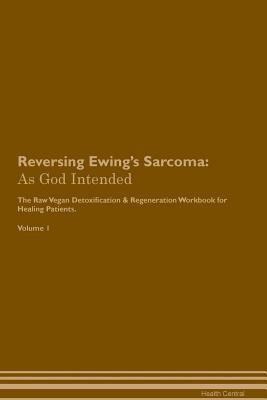Full Download Reversing Ewing's Sarcoma: As God Intended The Raw Vegan Plant-Based Detoxification & Regeneration Workbook for Healing Patients. Volume 1 - Health Central | PDF
Related searches:
Treatment Clinical Trials for Ewing Sarcoma - National Cancer Institute
Reversing Ewing's Sarcoma: As God Intended The Raw Vegan Plant-Based Detoxification & Regeneration Workbook for Healing Patients. Volume 1
Digging for Answers: Seeking a Cure for Ewing Sarcoma - St
The goal of this study was to review the current literature on the biology of ewing's sarcoma, including current treatments and the means by which an understanding of biological mechanisms could impact future treatments. A search of pubmed and the cochrane collaboration was performed. Both preclinical and clinical evidence was considered, but specific case.
Ewing sarcoma is the second most common bone cancer in pediatric patients. Although the primary cause of death in ewing sarcoma is metastasis, the mechanism underlying tumor spread needs to be elucidated. To this end, the role of the cxcr4/sdf-1a chemokine axis as a mediator of ewing sarcoma metastasis was investigated.
Ewing's sarcoma is a rare bone cancer primarily affecting children and adolescents. Ewing's sarcoma, a rare and aggressive bone cancer that affects adolescents, often begins with vague and non-specific symptom.
Ewing (yoo-ing) sarcoma is a rare cancerous tumor that grows in the bones or soft tissue around bones, such as the nerves or cartilage. It often begins in the long bones of the pelvis, legs, and arms, but a tumorous growth can also occur in the chest, spine, and any bone in the body.
Live a healthy lifestyle! subscribe to our free newsletters to receive latest health news and alerts to your email inbox.
Ariane’s sarcoma story: ewing sarcoma (bone) ariane shares her ewing sarcoma story, including going through chemotherapy� surgery� and radiation therapy� she also highlights how she dealt with being an aya (adolescent young adult) cancer patient� managing through depression� body positivity� and survivorship�.
Cytarabine inhibits the growth of ewing's sarcoma cells in vitro and in xenografts by reducing the expression of the ews–fli1 fusion gene and its protein product. Unfortunately, in a phase 2 cog study, none of ten patients responded, and only one had transient stabilisation of tumour.
If this hypothesis is correct, then reversing the shedding of s-fasl with an mmpi would result in accumulation of tm-fasl and cell death. We investigated this hypothesis by treating fas-sensitive and fas-resistant ewing's sarcoma family tumor/neuroblastoma cell lines with synthetic mmpis.
Ewing sarcoma (ews) is an aggressive mesenchymal tumor with unmet clinical need and significant social impacts on children, adolescents, and young adults. Cd99, a hallmark surface molecule of ews, participates in crucial biological processes including cell migration, differentiation, and death.
The ewing's sarcoma family of tumours (esft) is an aggressive form of childhood cancer, which include classic ewing's sarcoma, askin tumour, and peripheral primitive neuroectodermal tumour. While significant progress has been made in the diagnosis and treatment of localised disease over the past 30 years, there is much room for improvement.
Ewing's sarcoma is a very rare cancer that appears as a solid tumor, most often in children and teens. Most cases occur between ages 10 and 20, and about one what can we help you find? enter search terms and tap the search button.
Adamantinoma-like ewing family tumor (eft) is a rare subset of efts showing mixed features of ewing sarcoma and adamantinoma of the long bones. All currently reported cases of the adamantinoma-like type have been associated with bone. Recently, a unique type of eft was reported showing complex epith.
Nci supports clinical trials studying new and more effective ways to detect and treat cancer.
Sarcomas are rare cancers that form in the bones and soft tissues. Explore several sarcoma types as well as sarcoma risk factors, symptoms and treatments.
The ewing sarcoma gene encodes protein of uncertain function, while the fli product is a transcription factor. Accordingly, the resultant ews/fli fusion protein is placed under control of the ewing sarcoma promoter. While other translocations have also been described in es and pnet, including t(21;22) and t(7;22), all of the translocations.
The ewing sarcoma family of tumours (esft) encompass all the previous terminologies such as ewing sarcoma of bone, extra-skeletal ewing sarcoma, peripheral primitive neuroectodermal tumour, askin tumour of thoraco-pulmonary region, and atypical ewing sarcoma based on the presence of a unifying pathognomonic chromosomal translocation.
The definitive management of ewing's sarcoma of the spine, as in other locations, could include the combination of three main modalities: aggressive surgery, radiotherapy, and combined chemotherapy. Whenever possible, en bloc spondylectomy or extralesional resection is preferable, providing a better oncological result with a longer survival and a better preservation of the spine biomechanics.
When cancerous tumors form on connective tissues, it is a sarcoma. Sarcomas can either be bone or soft tissue, with additional sub-classifications depending on the origin of the cells (according to the sarcoma alliance).
Chromoplexy, a sudden burst of complex, loop-like gene rearrangements that gives rise to a fusion gene, appears to be associated with aggressive ewing sarcomas, subscribe to hematology news the contribution of genetic analysis to the curren.
The cic gene rearrangement exists in a subset of small round cell sarcomas. As the nosologic relationship of these sarcomas to ewing sarcomas remains undetermined, we examined 20 cic-rearranged sarcomas to compare their clinicopathologic features with those of ewing sarcomas.

Post Your Comments: